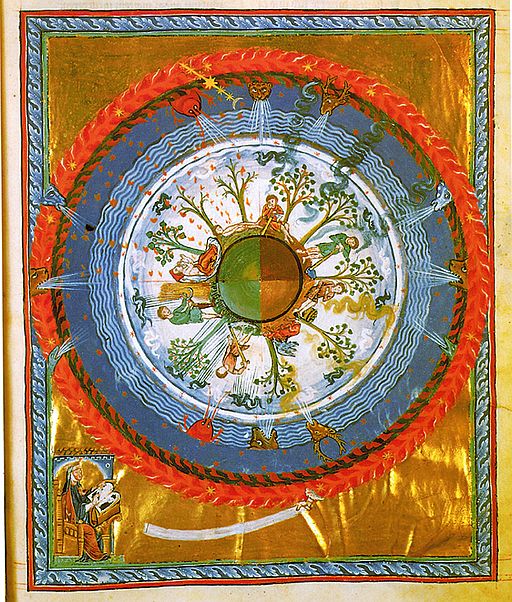By Linda Ryan
We cannot live in a world that is not our own, in a world that is interpreted for us by others. An interpreted world is not a home. Part of the terror is to take back our own listening, to use our own voice, to see our own light.
Don’t let yourself forget that God’s grace rewards not only those who never slip, but also those who bend and fall. So sing! The song of rejoicing softens hard hearts. It makes tears of godly sorrow flow from them. Singing summons the Holy Spirit. Happy praises offered in simplicity and love lead the faithful to complete harmony, without discord. Don’t stop singing. — Hildegard of Bingen
Once upon a time, a very long time ago, a baby girl was born to a knight and his wife. In those days the birth of a daughter meant several things, namely that she would have to be provided with a good dowry if she were to marry well, she could stay in the house as an unmarried girl and help care for her parents as they aged, or she could become a nun. This little girl grew up in a family where each was expected to do their particular jobs and even the children were taken in hand and taught to help the adults.
At the age of eight she was sent to a monastery to be educated. In those days, some monasteries were called double monasteries, meaning that they housed both nuns and monks although the two groups were separated most of the time. Monasteries usually took in children to be taught to do work that they would be expected to do when they became adults. For little girls like this one, they learned reading and writing so that they could keep the family accounts when they grew up and were married. They were taught to sew their clothes and to fancy them up a bit with embroidery and gold work. They were taught other things too, such as their catechism, prayers, hymns, and religious duties, under the auspices of the teaching nuns and priests. When the time came, usually in their early to mid teens, they had to make a choice between returning home or remaining at the monastery to take their vows.
At the age of eighteen, this little girl, now a woman, chose the monastery. For twenty years she served her community in the various tasks put before her, and then was elected the is of the monastery. This was not just an ordinary little girl grown up, this was a woman named Hildegard of Bingen, one of the strongest, wisest, most influential people of her century. A very good biography of Hildegard was written by James Kiefer which details many of the skills for which she became so recognized both then and now.
Women have always been a part of the church, a necessary part of the church. Women were the first to have word of the risen Christ. Women were teachers, preachers, and deacons, and probably priests in the early Christian era. Then they were pushed back into a twilight world where they went unrecognized except for a very exceptional few, like Hildegarde.
Kiefer points out that Hildegarde wouldn’t have called herself a feminist, even if the word had existed in her lifetime. She was concerned with all people and all creation. What she is, however, is a reminder that strong women have a place and a mission that the world needs to see and recognize. Even today’s strong women are still penalized by church, state, and industry simply because they are women. Many of them work quietly, helping one life at a time, but without recognition or often remuneration commensurate with their work. Hildegard could and did influence political leaders and even the Pope. We also have such women, some of whom are vilified even as they strive to do what it is God is calling them to do.
Perhaps now it’s time for another Hildegard to come forward, if we will just listen and look and try to find her. Perhaps it is one of us, one who has not been given visions for the gift of music or eloquence in preaching but one who has a mission and a calling, one who combines talents and gifts and abilities that could help make the world a better place for all.
Hildegard was a visionary, an artist, a musician, an eloquent writer and preacher, a wise counselor, and a servant of God above all. Wouldn’t it be wonderful if we women of today had someone like her that we could look up to and strive to emulate? What if we do have one–or a thousand? Are we looking for them, acknowledging them, and seeing the good they are doing in the world?
More than just seeing, are we helping others? Are we looking to the gifts of the earth for things that could heal or comfort? Are we listening for the music of visionaries and those who seek to lift our hearts to God in offering and supplication? Are we using art to show a better world? Are we writing to encourage others, to inform them of important issues, or even to encourage them to make good choices in areas that effect hundreds of thousands?
Is there a little Hildegard in any of us? Time to look inside and see if a tiny bit of her spirit and her dedication are present in me. I don’t want to be a saint, but I wouldn’t mind being strong, open, and wise.
Linda Ryan co-mentors 2 EfM Online groups and keeps the blog Jericho’s Daughter. She lives in the Diocese of Arizona and is proud to be part of the Church of the Nativity in North Scottsdale.
Image: By Deutsch: Hildegard von BingenEnglish: Hildegard of Bingen [Public domain], via Wikimedia Commons

